In the shadow of one of England’s oldest cathedrals sits Bishopscourt, the home of the Bishop of Rochester. Behind it is a traditional English garden that is being brought into the 21st century. Bishopscourt’s updated design is a revelation, with grasses, shrubs and perennials skillfully planted to create a kaleidoscope of flower and foliage color.
I was lucky to visit it this June on a glorious sunny afternoon, as the bishop opens it for a few days each year to the public through The National Gardens Scheme, an organization that schedules garden openings to raise money for a variety of charities.
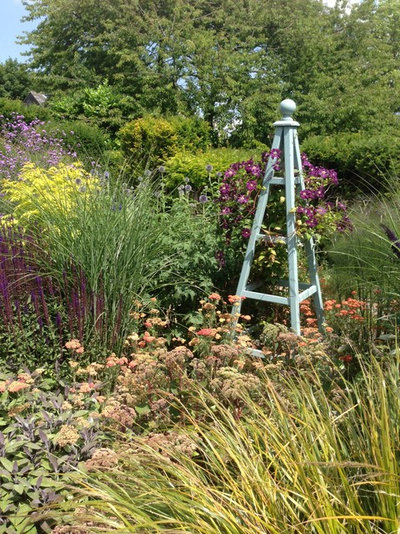
The garden contains many of the features you might expect in a garden with roots in the passions of Victorian and Edwardian gardeners — an expansive lawn, a rose garden and yew hedges — but I was surprised to find wonderful low-maintenance planting schemes and ideas that can easily be transported into our own garden plots.
The garden is large by town garden standards, about an acre, and is ably supported by a head gardener and a team of volunteers. Here are some ways they have updated the garden over the past couple of years while keeping maintenance costs down.
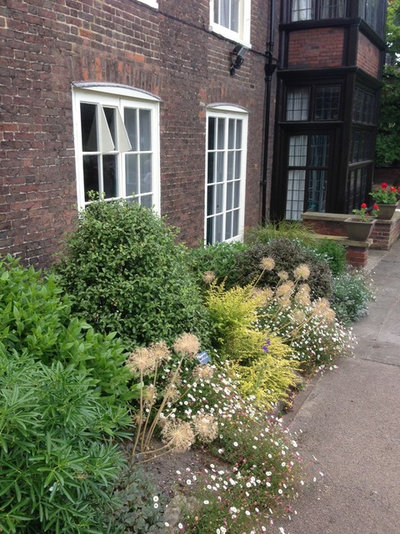 Labor-saving mixed shrubs.
Labor-saving mixed shrubs. The borders against the rear walls of Bishopscourt are planted with a mixture of labor-saving evergreen shrubs. Where once there may have been rose beds or even brightly colored bedding plants, now you’ll find bright-yellow box honeysuckle (
Lonicera nitida ‘Baggesen’s Gold’), small-leaved kōhūhū (
Pittosporum tenuifolium), deep green Laurustinus (
Viburnum tinus ‘Eve Price’) and Mexican orange blossom (
Choisya ternata ‘Aztec Pearl’), with its cut leaves.
The gardeners have left the dried flower heads of the globe-flowered alliums, whose skeletons now contrast well the dark foliage behind.
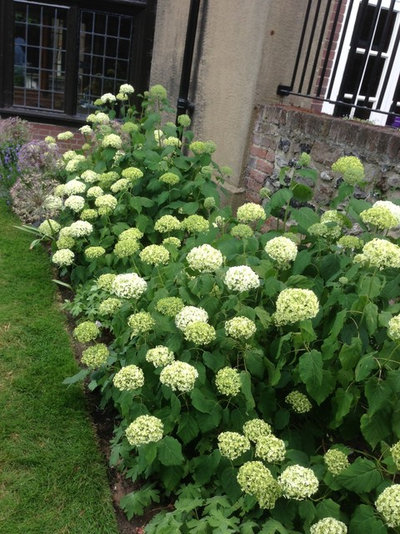 Repetition plantings.
Repetition plantings. Here the repetition of
Hydrangea arborescens ‘Annabelle’ throughout the border strengthens its visual impact while giving extra emphasis to the choice of plant. This newer variety of hydrangea, with its green-white blooms, spans a border close to the rear of the house, lifting a dark corner of the garden and creating a wonderful feature.
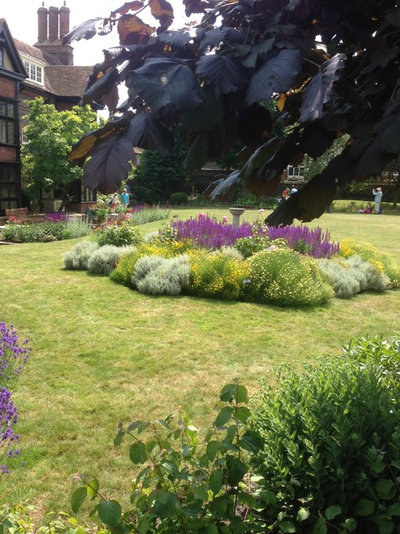 Common border plants for a riot of summer color.
Common border plants for a riot of summer color. A central lawn makes up the main body of the garden, used no doubt for diocese garden parties and croquet matches.
A circular bed set close to the rear of the house surrounds a simple stone sundial. Low-maintenance, flowering ground cover plants surround purple spires of woodland sage (
Salvia nemorosa). Instead of labor-intensive hybrid tea roses, these selections include two varieties of lavender cotton: the gray
Santolina chamaecyparissus and the green-leaved
Santolina virens, with its tight ball-like flowers of acid yellow
.
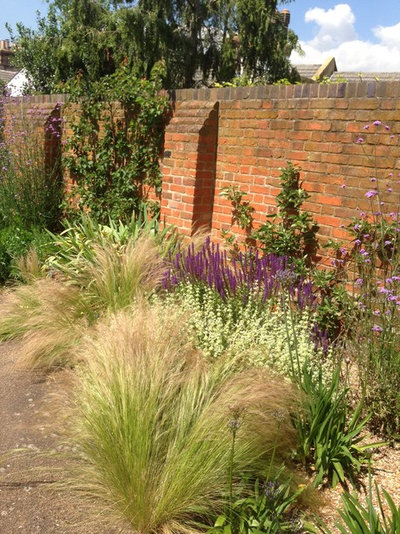 Planting to suit conditions.
Planting to suit conditions. Southeast England, especially Kent, has an almost continental climate, with dry summers and cold winters. The planting in front of this wall takes these conditions into account.
A standard border planting of herbaceous perennials may have grown here once. Here we see a more suitable choice of plants, including billowing Mexican feather grass (
Stipa tenuissima),
bright purple woodland sage (
Salvia nemorosa) and, overhead, tall verbena (
Verbena bonariensis) with its swaying flowers.
Fan-trained Victoria plum trees have recently been planted to take advantage of the sun-warmed brick wall that encloses the garden. The bed has been mulched with a thick layer of gravel to aid water retention.
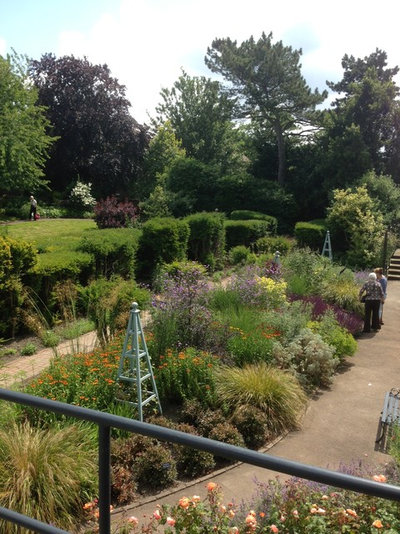 Overplanting to create low-maintenance summer color.
Overplanting to create low-maintenance summer color. A clipped yew hedge (
Taxus baccata) borders the back of the lawn and separates it from the parterre at the rear of the garden.
The parterre is really the jewel of the garden, with exquisite mixed plantings that you would not normally expect in a garden of this type and age. An almost overplanted mixture of mainly herbaceous perennials and ornamental grasses, sometimes referred to as a perennial meadow, is punctuated by three painted wooden trellis obelisks that support purple-flowered clematis.
Though the planting scheme varies throughout the large parterre border, the use of the three painted obelisks combined with the use of the tall purple verbena (
Verbena bonariensis) along the spine of the border creates cohesion.
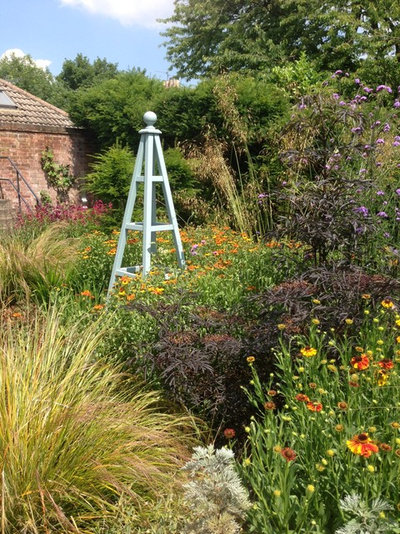
One of the obelisks is set in a sea of warm-colored Heleniums that contrast beautifully with the almost-black
Sambucus nigra ‘Black Lace’. Movement in the plantings is provided by the tall flowering plumes of giant feather grass (
Stipa gigantea) and the purple inflorescences of tall verbena (
Verbena bonariensis)
.
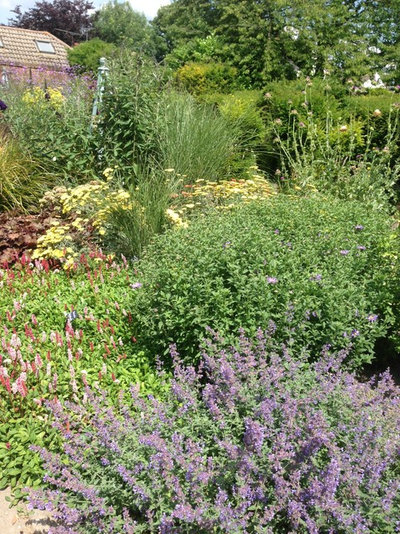
Another colorful mixture of plants in the parterre shows the gardeners’ skill at creating a scheme that has foliage and flower interest throughout the summer.
While others wait their turn to flower, here we see the pink
Polygonum affine and powder-blue catmint (
Nepeta ‘Six Hills Giant’) edging the path, while in the body of the planting, the sulphur-yellow flowers of moonshine yarrow (
Achillea ‘Moonshine’) take center stage.
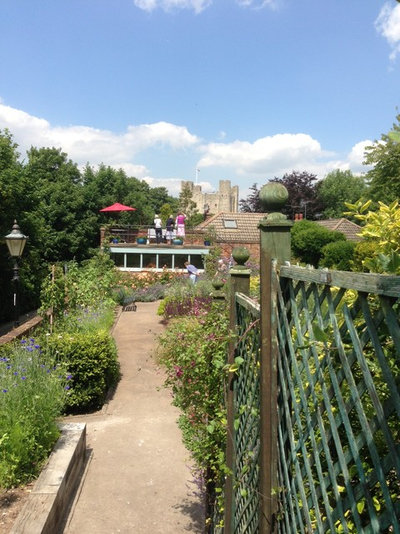 A successful wildflower meadow in the smallest space.
A successful wildflower meadow in the smallest space. A wide walkway runs along the back of the parterre at the very rear of the garden and leads to a raised seating area above a summer house. One side of the path borders the bold planting of the parterre, while the other is composed of low raised beds filled with English wildflowers.
“Easy sow“ wildflower seed mixtures are very popular with gardeners in the U.K., and there are many to choose from in garden centers. Many gardeners are disappointed with the results they get when they broadcast wildflower seeds in borders, but here in raised beds, they look amazing.
In the distance, above the trees, you can see the Norman keep of Rochester Castle. Built in 1127, the castle still dominates the skyline of the town.
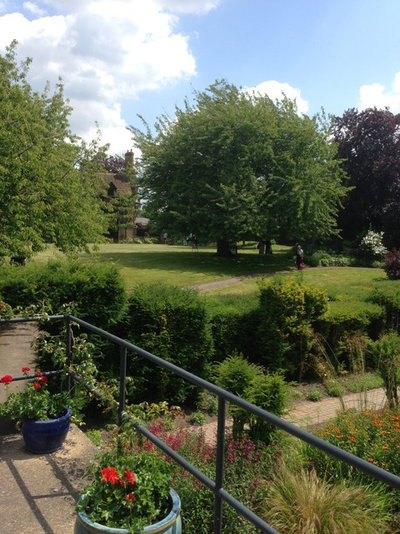
The view from the raised seating area looks back over the lawns to the house beyond. The mature trees set within the lawn include a mature tulip tree (
Liriodendron tulipifera).
Info: Bishopscourt Garden is open to the public twice a year, in June and September, through The National Gardens Scheme. The next scheduled dates are September 6–7, 2014.
See more inspiring garden tours





